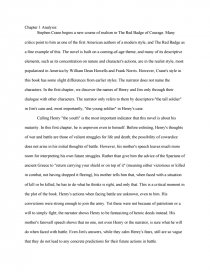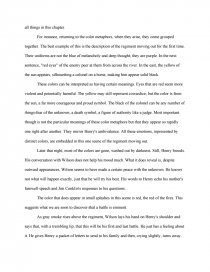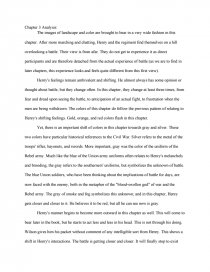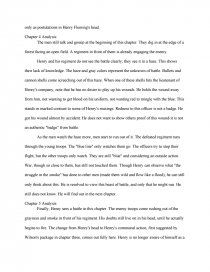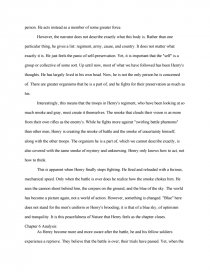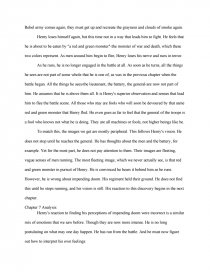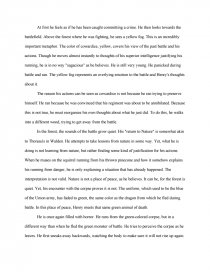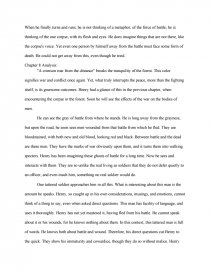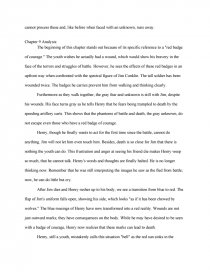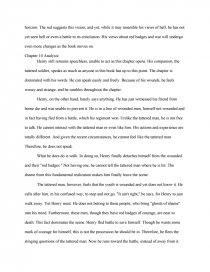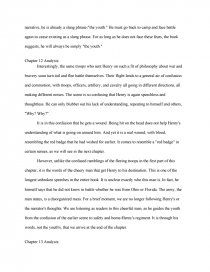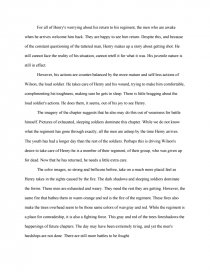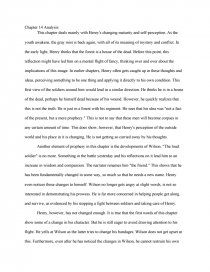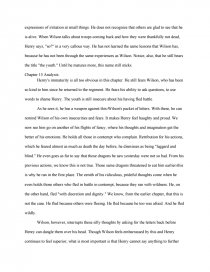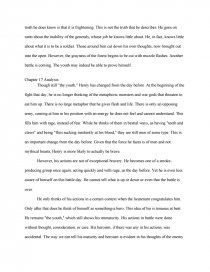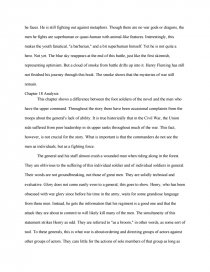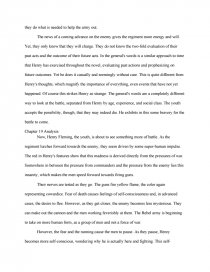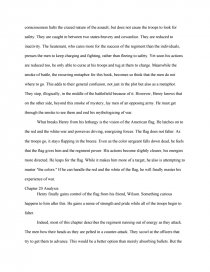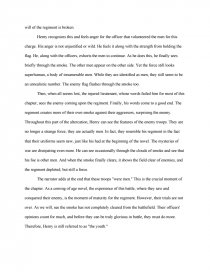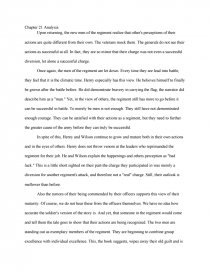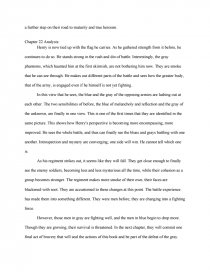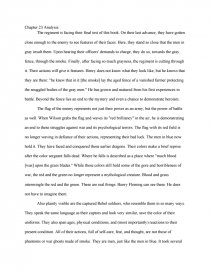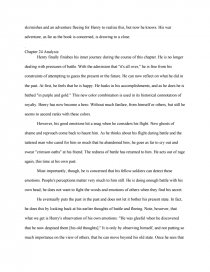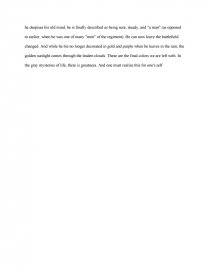Red Badge of Courage
Essay by review • December 13, 2010 • Research Paper • 9,451 Words (38 Pages) • 3,755 Views
Essay Preview: Red Badge of Courage
Chapter 1 Analysis:
Stephen Crane begins a new course of realism in The Red Badge of Courage. Many critics point to him as one of the first American authors of a modern style, and The Red Badge as a fine example of this. The novel is built on a coming-of-age theme, and many of its descriptive elements, such as its concentration on nature and character's actions, are in the realist style, most popularized in America by William Dean Howells and Frank Norris. However, Crane's style in this book has some slight differences from earlier styles. The narrator does not name the characters. In the first chapter, we discover the names of Henry and Jim only through their dialogue with other characters. The narrator only refers to them by descriptors‹"the tall soldier" in Jim's case and, most importantly, "the young soldier" in Henry's case.
Calling Henry "the youth" is the most important indicator that this novel is about his maturity. In this first chapter, he is unproven even to himself. Before enlisting, Henry's thoughts of war and battle are those of valiant struggles for life and death; the possibility of cowardice does not arise in his initial thoughts of battle. However, his mother's speech leaves much more room for interpreting his own future struggles. Rather than give him the advice of the Spartans of ancient Greece to "return carrying your shield or on top of it" (meaning either victorious or killed in combat, not having dropped it fleeing), his mother tells him that, when faced with a situation of kill or be killed, he has to do what he thinks is right, and only that. This is a critical moment in the plot of the book. Henry's actions when facing battle are unknown, even to him. His convictions were strong enough to join the army. Yet these were not because of patriotism or a will to simply fight; the narrator shows Henry to be fantasizing of heroic deeds instead. His mother's farewell speech shows that no one, not even Henry or the narrator, is sure what he will do when faced with battle. Even Jim's answers, while they calm Henry's fears, still are so vague that they do not lead to any concrete predictions for their future actions in battle.
Yet Crane has written into this novel a way to tell certain characteristics even without explicit direction from the narrator‹the use of color metaphors. The title itself is a color metaphor. "The red badge of courage" could refer to an actual award given for heroism; yet it surely refers to a wound from battle. The "red badge" shows your valiancy by proving you were bold and brave enough to fight until wounded. However, as we see in the first chapter with the mother's speech, this courage is not guaranteed. Indeed, every man killed in battle would have a red badge, and still be dead.
Crane uses color metaphors to imply certain meanings throughout the book. An example of this in the first chapter is Henry's mother's discouragement is described as throwing a "yellow light upon the color of his ambitions." The use of yellow here is deliberate; it refers to cowardice or "being yellow." Henry somehow sees denying his heroic dreams as necessarily falling to cowardice, as this metaphor shows.
As the first chapter ends, we have been introduced to the characters, but also shown that they are even uncertain of whom they are and how they will act. Developments come in later chapters.
Chapter 2 Analysis:
This chapter of The Red Badge of Courage is dominated by Henry's mixed feelings about the upcoming battle. He goes back and forth in thoughts about himself and his fellow soldiers. One moment, he feels that he and they will both fight like brave heroes. The next, he is sure that he is not meant to be a soldier and neither are his companions. If they seem upbeat and happy, they are hiding a deep fear.
It does not matter at this point which one of these interpretations about the men is correct. It is Henry himself who is most important and who the novel follows closely. Because of this, his own feelings of fear and bravery and (above all) uncertainty dominate and tint the perception of all things in this chapter.
For instance, returning to the color metaphors, when they arise, they come grouped together. The best example of this is the description of the regiment moving out for the first time. Their uniforms are not the blue of melancholy and deep thought; they are purple. In the next sentence, "red eyes" of the enemy peer at them from across the river. In the east, the yellow of the sun appears, silhouetting a colonel on a horse, making him appear solid black.
These colors can be interpreted as having certain meanings. Eyes that are red seem more violent and potentially harmful. The yellow may still represent cowardice; but the color is from the sun, a far more courageous and proud symbol. The black of the colonel can be any number of things‹fear of the unknown, a death symbol, a figure of authority like a judge. Most important though is not the particular meanings of these color metaphors but that they appear so rapidly one right after another. They mirror Henry's ambivalence. All these emotions, represented by distinct colors, are embedded in this one scene of the regiment moving out.
Later that night, most of the colors are gone, washed out by darkness. Still, Henry broods. His conversation with Wilson does not help his mood much. What it does reveal is, despite outward appearances, Wilson seems to have made a certain peace with the unknown. He knows not what will happen exactly, just that he will try his best. His words to Henry echo his mother's farewell speech and Jim Conklin's responses to his questions.
The color that does appear in small splashes in this scene is red, the red of the fires. This suggests what we are soon to discover‹that a battle is eminent.
As gray smoke rises above the regiment, Wilson lays his hand on Henry's shoulder and says that, with a trembling lip, that this will be his first and last battle. He just has a feeling about it. He gives Henry a packet of letters to send to his family and then, crying slightly, turns away.
Chapter 3 Analysis:
The images of landscape and color are brought to bear in a very wide fashion in this chapter. After more marching and chatting, Henry and the regiment find themselves on a hill overlooking a battle. Their view is from afar. They do not get to experience it as direct participants and are therefore detached from the actual experience of battle (as we are to find in later chapters, this experience looks and feels quite different from this first view).
Henry's feelings
...
...
